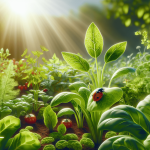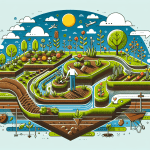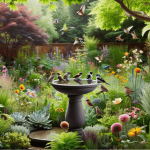This post may contain affiliate links. As an Amazon Associate, we may earn commissions from qualifying purchases.
Have you ever wondered how you can transform your small urban space into a thriving ecosystem that not only looks stunning but also supports local wildlife? Creating a garden that promotes biodiversity, especially in the concrete jungle, is a delightful and achievable endeavor. It can be your little patch of paradise right in the middle of the city, buzzing with life and activity.
A garden full of biodiversity means inviting a range of plants, animals, birds, and insects—and almost anyone that flies, buzzes, or hops about—to take up residence in your little slice of greenery. With a bit of planning and thoughtful choices, you can make your urban garden a haven for these urban dwellers.
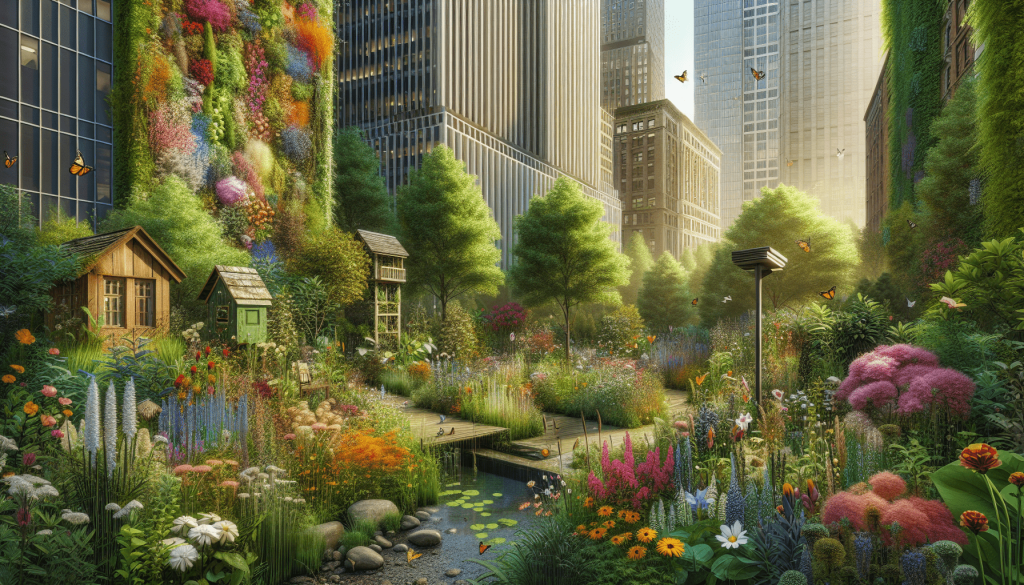
Understanding Biodiversity in an Urban Context
First of all, what exactly does biodiversity mean when it comes to your garden? Biodiversity refers to the variety of life in a particular habitat. In the context of your garden, it involves incorporating a variety of plant species that provide food and shelter to microorganisms, insects, birds, and other wildlife. The goal here is to create a balanced and sustainable ecosystem within your urban garden.
Why is Biodiversity Important?
Biodiversity is not just a term for scientists to throw around; it plays a critical role in maintaining ecosystem balance. High biodiversity helps to keep your garden healthy and resilient. It ensures that each organism, from the smallest insect to larger fauna, plays its part in the natural cycle. In practical terms, this means that your garden is less vulnerable to pests and diseases, and it requires less maintenance in the long run.
Benefits of a Biodiverse Urban Garden
The ecological impact of a biodiverse garden is significant. You provide shelter and food to various life forms, contributing to their conservation. But the benefits extend beyond just playing host to wildlife. A biodiverse garden also enriches soil quality, improves air quality, and makes your surroundings more beautiful and tranquil—a true oasis amidst urban chaos.
Planning Your Garden for Maximum Biodiversity
Sketching out a plan for your garden is like drawing a roadmap. It helps you visualize how your garden will develop over time and ensure everything fits together cohesively.
Assess Your Space
Start by taking a stroll around your area. Note the amount of sunlight different parts receive, identify shaded areas, and recognize any microclimates. Consider your space’s dimensions, existing structures, and anything that might limit your planting choices, such as overhead wires or underground pipelines.
Understand Your Soil
Understanding your soil’s properties is crucial. Conduct a simple pH test, which you can purchase at a garden center, to see if it’s acidic, neutral, or alkaline. Determine if it’s clay, sand, loam, or a mix. This will inform you which plants will thrive best in your soil conditions and what amendments might be necessary.
Native Plants Are Your Friends
Native plants are adapted to your local climate, soil, and organisms, making them a great choice for promoting biodiversity. They require less water, are more resilient to local pests, and provide vital resources like nectar for native pollinators. Research or reach out to local garden centers to find out which plants are native to your area.
Choosing the Right Plants and Structures
The choice of plants and garden structures is substantial when aiming to attract and sustain diverse life forms.
Layers, Layers, Layers
One of the fundamental concepts in turning your space into a biodiverse garden is layering plant life. Mimicking natural ecosystems with various layers—from ground covers and herbaceous plants to shrubs and trees—creates more habitats and niches for differing species.
Ground Level: Ground Covers
Ground covers can include mosses, sedums, and creepers. These plants are instrumental in covering exposed soil, reducing erosion, and providing habitat for beetles and other small creatures.
Mid-Level: Herbaceous and Shrubs
The mid-level involves flowering plants and shrubs. These can offer food and nesting sites for mammals and birds. Think of lovely perennials like coneflowers, lavender, or shrubs like holly and hawthorn.
Vertical Level: Trees and Climbers
Finally, trees or climbing plants like ivy or clematis can add height and support other wildlife. Even a single tree can be home to many organisms, from birds to insects.
Seasonality is Key
Choose plants that provide interest and benefits throughout the year. Evergreens can provide benefits year-round, while decidaries can offer vibrant autumn colors or springtime fruits. Balancing plant types ensures that something is always blooming or providing resources, which is crucial for sustaining wildlife through the seasons.
Design Features for a Biodiverse Haven
Design features are like little bonuses that elevate your garden from a lovely space to a biodiverse oasis.
Create a Miniature Pond
Water is life, and incorporating a small pond or water feature can immensely boost your garden’s biodiversity. A pond caters to various creatures, from frogs and salamanders to birds drawn to drink or bathe. Ensure there are shallow sides for easy animal access and exit.
Offer Shelter with Logs and Stones
A pile of logs or stones might look rustic, but they offer great hiding places for insects, amphibians, and reptiles. This feature can become a permanent home or a temporary shelter from predators.
Birdhouses, Bat Boxes, and Bug Hotels
Encourage different species by installing structures like birdhouses, bat boxes, and bug hotels. They provide safe roosting, breeding options, and overwintering for various creatures.
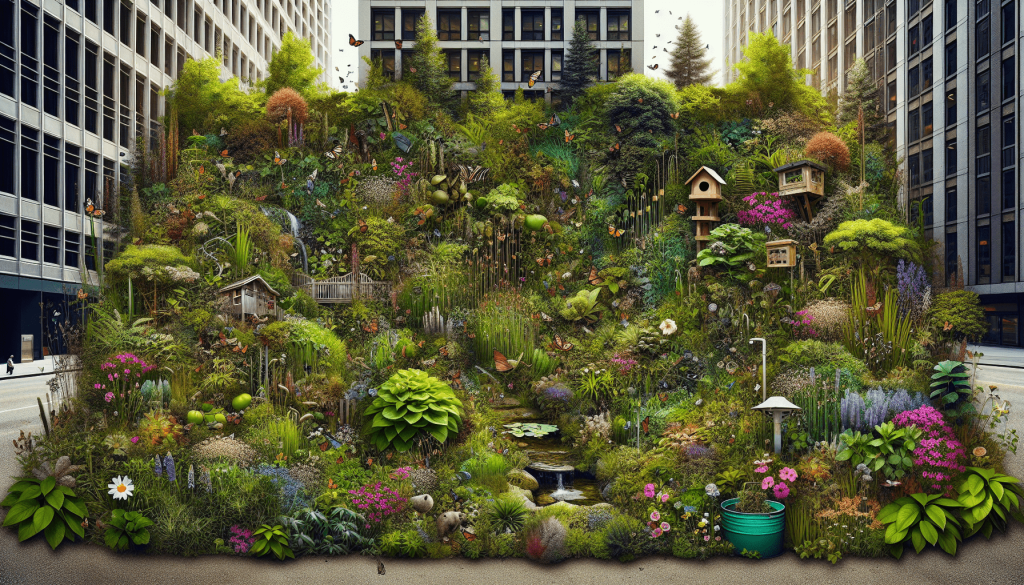
Promote Pollinators
Pollinators play an essential role in plant reproduction, and their presence is a true indicator of a successful biodiverse garden.
Butterflies, Bees, and Beyond
Plants like lavender, sunflowers, and wild bergamot attract butterflies, bees, and even hummingbirds. These hard workers help transfer pollen, ensuring your garden stays fertile and fruitful.
Avoid Pesticides
While it can be tempting to turn to pesticides to manage pests, they often harm the very creatures you want to attract, including beneficial insects. Consider natural pest management strategies, fostering a balanced ecosystem that can handle pests naturally.
Consider Sustainable Practices
Sustainability isn’t just a buzzword; it brings genuine benefits to your urban garden.
Composting
Create your composting system for organic waste. Compost enriches your soil, improves plant health, and reduces your carbon footprint. It’s a win-win!
Rainwater Harvesting
Consider setting up a rainwater harvesting system. Reusing rainwater reduces your dependency on municipal sources and keeps your garden green without wasting treated tap water.
Protect and Conserve Resources
Mulching your soil with bark or leaf litter reduces water evaporation, suppresses weeds, and adds organic matter back into the earth as it decays. Choose biodegradable products wherever possible.
Enjoy, Learn, and Repeat
Gardening for biodiversity is not a one-time project but a continuous celebration of life in its many forms.
Observe and Adapt
As your garden grows and matures, observe how different species interact with your space. Take notes and photographs, and adjust plantings and features as you learn what works and what could be improved.
Educate and Inspire
Share your journey and discoveries with neighbors and community. Hosting a tour of your garden or joining local gardening clubs can spread awareness and inspire others to take similar actions.
Celebrate the Little Things
Each flutter of a butterfly wing and each glimpse of a visiting robin is a reminder of why you embarked on this gardening journey. Savor these moments and appreciate the quiet, thriving life in your urban space.
If you’re asking, “How can I create a garden that promotes biodiversity in an urban setting?” remember that each step, from choosing plants to implementing eco-friendly practices, contributes to creating a lush, diverse, and vibrant habitat. Your small urban garden has the potential to unite beauty and nature in such a way that not only transforms your immediate environment but also contributes positively to the broader ecosystem.



